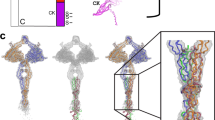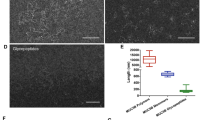Abstract
THE surface of the stomach is covered by a layer of mucous gel which protects the underlying mucosa from the harmful, acidic stomach contents. The principal component of the gel has been isolated from pig gastric mucus, purified, and shown to be a glycoprotein of molecular weight 2×106 (Table 1)1,2. This glycoprotein consists of four equal sized subunits (molecular weight 5 × 105) joined by disulphide bridges3,4. Each glycoprotein subunit consists of a protein core, 14% by weight of the glycoprotein, with carbohydrate side chains attached. The protein core consists of two regions, one rich in serine, threonine and proline and bearing all the carbohydrate, the other having an amino acid composition characteristic of a globular protein. The latter contains cystine residues which bridge the four subunits. Mild reducing agents and proteolytic enzymes each split the glycoprotein into four subunits4,5. The carbohydrate chains, approximately 15 residues in a branched structure, account for 82% by weight of the glygoprotein and carry ester sulphate residues. The problem therefore is to explain how such a glycoprotein molecule can associate to form a gel which in vivo is essentially impermeable to proteolytic enzymes and which can act as a barrier to protons probably by supporting a pH gradient.
This is a preview of subscription content, access via your institution
Access options
Subscribe to this journal
Receive 51 print issues and online access
$199.00 per year
only $3.90 per issue
Buy this article
- Purchase on Springer Link
- Instant access to full article PDF
Prices may be subject to local taxes which are calculated during checkout
Similar content being viewed by others
References
Allen, A., and Snary, D., Gut, 13, 666–672 (1972).
Snary, D., Allen, A., and Pain, R. H., Eur. J. Biochem., 24, 183–189 (1971).
Snary, D., Allen, A., and Pain, R. H., Biochem. biophys. Res. Commun., 40, 844–851 (1970).
Starkey, B. J., Snary, D., and Allen, A., Biochem. J., 141, 633–639 (1974).
Scawen, M., and Allen, A., Biochem. Soc. Trans., 3, 1107–1109 (1975).
Robson, T., Allen, A., and Pain, R. H., Biochem. Soc. Trans., 3, 1105–1107 (1975).
Porter, R. S., and Johnson, J. F., Chem. Rev., 66, 1–27 (1966).
Yang, J. T., Adv. Protein Chem., 16, 323–401 (1961).
Lloyd, K. O., and Kabat, E. A., Proc. natn. Acad. Sci. U.S.A., 61, 1470–1477 (1968).
Rees, D. A., Adv. Carbohydrate Chem. Biochem., 24, 267–314 (1969).
Author information
Authors and Affiliations
Rights and permissions
About this article
Cite this article
ALLEN, A., PAIN, R. & ROBSON, T. Model for the structure of the gastric mucous gel. Nature 264, 88–89 (1976). https://doi.org/10.1038/264088a0
Received:
Accepted:
Issue Date:
DOI: https://doi.org/10.1038/264088a0
This article is cited by
-
The antibiotic vancomycin induces complexation and aggregation of gastrointestinal and submaxillary mucins
Scientific Reports (2020)
-
Mucus and Mucins: do they have a role in the inhibition of the human immunodeficiency virus?
Virology Journal (2017)
-
Histochemical study of intestinal mucins after administration of silver nanoparticles in Sprague–Dawley rats
Archives of Toxicology (2010)
-
Viscous fingering of HCI through gastric mucin
Nature (1992)
-
Circadian rhythms of gastric mucus efflux and residual mucus gel in the fasting rat stomach
Digestive Diseases and Sciences (1991)
Comments
By submitting a comment you agree to abide by our Terms and Community Guidelines. If you find something abusive or that does not comply with our terms or guidelines please flag it as inappropriate.



